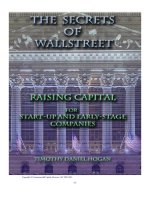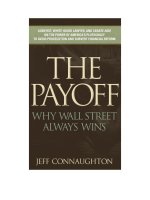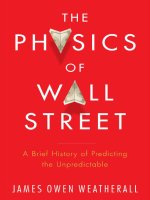goldberg - the battle for wall street (2009)
Bạn đang xem bản rút gọn của tài liệu. Xem và tải ngay bản đầy đủ của tài liệu tại đây (1.53 MB, 259 trang )
$29.95 USA / $32.95 CAN
A
confl ict of epic fi nancial proportions has
begun on Wall Street and will continue to
rage on in the coming years. The opposing
forces are the sellers: an army of commercial and
investment bankers; and the buyers: an army of hedge
fund managers and private equity groups. It is a battle
about power—and about winning the hearts, minds,
and wallets of the investment community. In The Battle
for Wall Street, twenty-fi ve-year Wall Street veteran
Richard Goldberg analyzes the struggle for power
between traditional sell-side fi nancial institutions—
who have seen their dominance upended during the
2008 fi nancial crisis—and buy-side newcomers, and
tells what it means for you and your fi nancial future.
Goldberg explains how, for over 100 years, the sellers
held all the power. They made markets, controlled
information about markets, and largely managed
markets, while buyers were participants with limited
power or infl uence, or none at all. He shows how,
with the revolution in information technology, buyers
gained access to the same data as the sellers and quickly
became an equally powerful force in the marketplace—
just as the numerous new pools of liquidity made
money more readily available. The author examines
the various drivers of large-scale trading technology,
the “agents of change” that include private equity,
hedge funds, endowments, sovereign wealth funds,
and the major exchanges that are fast becoming global
fi nancial supermarkets.
With an insider’s eye, he looks at the various strategies
and initiatives currently under way as a wide range of
powerful fi rms fi ght to manipulate this new generation
of fi nancial technology to their advantage. Throughout
the book, he draws on the experiences of many of
the sell- and buy-side “generals” in the battle.
With prominent sell-side players either out of business
or humbled into restructuring as commercial banks,
Goldberg offers dire predictions for some and success
for others. And as Goldberg reveals the factors that
will create future winners, those who stay ahead of
these changes will profi t in their careers and their
investments. This book will be your guide.
(CONTINUED FROM FRONT FLAP)
(CONTINUED ON BACK FLAP)
Jacket Design: Paul McCarthy
Jacket Imagery: Composite of © Getty Images
RICHARD GOLDBERG is a twenty-fi ve-year
Wall Street veteran with Lehman Brothers, Lazard, and
Wasserstein Perella. He has been a banker to the banks
and advised on a number of transformational fi nancial
services transactions. He is also a faculty member at
Columbia University’s School of International and Public
Affairs and has taught at Boston College’s Carroll School
of Management and Brandeis University’s International
Business School.
BEHIND THE LINES IN
THE STRUGGLE THAT PUSHED AN
INDUSTRY INTO TURMOIL
BEHIND THE LINES IN THE
STRUGGLE THAT PUSHED
AN INDUSTRY INTO TURMOIL
GOLDBERG
k
k
An insider’s look at the changing balance
of power on Wall Street
A monumental battle is raging in the ever-shifting, always tumultuous world
of Wall Street. The Battle for Wall Street follows the struggle for power
between two giants: the sellers, traditional commercial and investment banks;
and the buyers, upstart hedge funds, private equity fi rms, and the like.
Richard Goldberg—who has spent thirty years working with fi nancial
industry leaders—gives you a detailed understanding of what is going on in
this dynamic arena and the forces behind the shift of power from the old sell-
side gatekeepers to the new buy-side players.
The Battle for Wall Street examines the instruments of change—liquidity and
fi nancial technology—and the agents of change: hedge funds, private equity,
fi nancial entrepreneurs, endowments, exchanges, and sovereign wealth funds.
Even more importantly, it outlines the strategic implications for the winners
and losers. Goldberg describes all this against the dramatic backdrop of the
subprime mortgage and credit crisis and the resulting capitulation of global
fi rms such as Bear Stearns and Lehman Brothers.
Goldberg’s unique access to major players brings this book to life with
fascinating anecdotes and stories about the fi nancial generals who have left
their mark in the battle for Wall Street.
ffirs.indd ivffirs.indd iv 11/22/08 4:24:11 PM11/22/08 4:24:11 PM
The Battle for
Wall Street
Behind the Lines in the
Struggle that Pushed an
Industry into Turmoil
Richard Goldberg
John Wiley & Sons, Inc.
ffirs.indd iffirs.indd i 11/22/08 4:24:10 PM11/22/08 4:24:10 PM
Copyright © 2009 by Richard Goldberg. All rights reserved.
Published by John Wiley & Sons, Inc., Hoboken, New Jersey.
Published simultaneously in Canada.
No part of this publication may be reproduced, stored in a retrieval system, or transmitted
in any form or by any means, electronic, mechanical, photocopying, recording, scanning,
or otherwise, except as permitted under Section 107 or 108 of the 1976 United
States Copyright Act, without either the prior written permission of the Publisher,
or authorization through payment of the appropriate per-copy fee to the Copyright
Clearance Center, Inc., 222 Rosewood Drive, Danvers, MA 01923, (978) 750-8400, fax
(978) 750-4470, or on the web at www.copyright.com. Requests to the Publisher for
permission should be addressed to the Permissions Department, John Wiley & Sons, Inc.,
111 River Street, Hoboken, NJ 07030, (201) 748-6011, fax (201) 748-6008, or online at
/>Limit of Liability/Disclaimer of Warranty: While the publisher and author have used their
best efforts in preparing this book, they make no representations or warranties with respect
to the accuracy or completeness of the contents of this book and specifi cally disclaim any
implied warranties of merchantability or fi tness for a particular purpose. No warranty
may be created or extended by sales representatives or written sales materials. The advice
and strategies contained herein may not be suitable for your situation. You should consult
with a professional where appropriate. Neither the publisher nor author shall be liable for
any loss of profi t or any other commercial damages, including but not limited to special,
incidental, consequential, or other damages.
For general information on our other products and services or for technical support, please
contact our Customer Care Department within the United States at (800) 762-2974,
outside the United States at (317) 572-3993 or fax (317) 572-4002.
Wiley also publishes its books in a variety of electronic formats. Some content that appears
in print may not be available in electronic books. For more information about Wiley
products, visit our web site at www.wiley.com.
Library of Congress Cataloging-in-Publication Data:
Goldberg, Richard (Richard S.)
The battle for Wall Street : behind the lines in the struggle that pushed an industry
into turmoil / Richard Goldberg.
p. cm.
Includes bibliographical references and index.
ISBN 978-0-470-22279-9 (cloth)
1. Investment advisors—United States. 2. Investments—United States. 3. Finance—
United States. 4. Stock exchanges—New York (State)—New York. I. Title.
HG4928.5.G65 2009
332.64'273—dc22
2008038662
Printed in the United States of America
10 9 8 7 6 5 4 3 2 1
ffirs.indd iiffirs.indd ii 11/22/08 4:24:11 PM11/22/08 4:24:11 PM
To my wife, Jill, and my children, Brett and Nikki
For their love, encouragement and endless patience.
ffirs.indd iiiffirs.indd iii 11/22/08 4:24:11 PM11/22/08 4:24:11 PM
ffirs.indd ivffirs.indd iv 11/22/08 4:24:11 PM11/22/08 4:24:11 PM
v
Contents
Acknowledgments vii
Introduction: Let the Battle for Wall Street Begin ix
Part One: Instruments of Change 1
Chapter 1 Sea of Liquidity 3
Chapter 2 Financial Information in a Digital Age 17
Chapter 3 Prime Brokerage Meeting Hall 37
Part Two: Agents of Change 47
Chapter 4 Hedge Funds: Buy-Side Player, Sell-Side Foe 49
Chapter 5 Private Equity: Buy-Side Player,
Sell-Side Friend 67
Chapter 6 Entrepreneurs to Endowments:
Buy-side Catalysts 87
Chapter 7 Exchanges: Sell-Side Voice,
Buy-Side Electronics 107
Chapter 8 Sovereign Wealth Funds: Sell Side Today,
Buy Side Tomorrow 123
ftoc.indd vftoc.indd v 11/22/08 4:25:14 PM11/22/08 4:25:14 PM
vi contents
Part Three: Implications of Change 135
Chapter 9 Sell-Side Casualties, Buy-Side Implications 137
Chapter 10 Buy-Side Casualties, Sell-Side Implications 155
Chapter 11 Regulatory Implications 171
Chapter 12 Future Implications 191
Notes 205
About the Author 235
Index 237
ftoc.indd viftoc.indd vi 11/22/08 4:25:15 PM11/22/08 4:25:15 PM
vii
Acknowledgments
M
y ineffable gratitude to James Mossman, a brilliant tactician
and a better friend, Michael Kraines, an instrumental col-
league in bringing this book to life, and Ed Hajim and
Bruce Wasserstein, the driving infl uences of my Wall Street career.
I will always be indebted to Dean John Coatsworth, Rob Garris
and Katharine Morgan from Columbia University; Dean Andy Boynton, Edie
Hotchkiss, and Hassan Tehranian from Boston College; and Edward Bayone
from Brandeis University for making my dream of a “second act ” come true.
My deepest appreciation to Kelly O ’ Connor, the hardest - working
development editor; Dave Pugh, a reassuring senior editor; Stacey
Fischkelta, a patient senior production editor; and Alan Horowitz and
Neil Plakcy for their guidance in navigating me through the rocky ter-
rain of pushing a book forward. Matthew Berninger, Jessica Hunt, and
Christopher Kaminker also provided invaluable assistance in research.
I am humbled and inspired by Steve Begleiter, Buzzy Geduld, Jeff
Lane, Greg Meredith, Ben Phillips, Lou Ricciardelli, Gary Talarico,
Catherine Taylor, and Mark Utay for sharing their fi nancial pearls of wis-
dom which substantially increased the book ’ s intellectual heft.
flast.indd viiflast.indd vii 11/22/08 4:24:40 PM11/22/08 4:24:40 PM
My loyalty and admiration to a cadre of friends who endured my
obsessing over writing and rewriting this continually evolving drama:
Ricardo Gomez Acebo, Reuben Auspitz, Joe Carson, Steve Feldman,
Phil Friedman, David Goldhill, Matt Kissner, Barry Klein, Sherri
Mahne, Bill Manning, Peter Marber, Jeff Silver, Joe Stein, and Joe
Yurcik.
I would be remiss to exclude a special thanks to my wife, Jill, for
being an invaluable set of eyes and ears, John Prior for his time and
practical expertise, Chris Toro for her kind gestures, and Father James
Woods for making the world a better place.
Finally, my parents and my in - laws instilled in me the value of a
good education, specifi cally the importance of studying history and
learning from it. To the above mentioned and many more, thank you
for helping lead the charge of The Battle for Wall Street.
viii acknowledgments
flast.indd viiiflast.indd viii 11/22/08 4:24:40 PM11/22/08 4:24:40 PM
ix
Introduction
Let the Battle for Wall Street Begin
The Battle for Wall Street.
I chose this phrase as the title for my book because, over the past
two decades, a battle of major fi nancial proportions has commenced
on Wall Street, and as everyone is all too aware, it continues to rage as I
write.
The battle is primarily between two giant armies — the buyers,
whose soldiers come from such places as hedge funds; and the sellers,
whose armed forces come from such places as hybrid commercial/
investment banks. In addition, other participants — like exchanges, sov-
ereign wealth funds, endowment funds and fi nancial entrepreneurs —
have joined the battle along the way.
In 2008, the battle for the Street found its way into my classroom.
Just as the rise of the free agent changed the game of baseball, the new
roles that aspiring Wall Street types are interested in today are very dif-
ferent than the ones I used to play when I was fi rmly planted as an
investment banker.
flast.indd ixflast.indd ix 11/22/08 4:24:40 PM11/22/08 4:24:40 PM
In class, I discuss the theories behind global markets and fi nancial
institutions, along with the practical applications I ’ ve learned during
my 25 - year career. I share personal anecdotes and war stories and try to
narrate the excitement of a career spent on the front lines of fi nance.
My students, though, are interested in something else entirely — it ’ s
as though I ’ m recounting tales of what it was like when the World
Series was played during the daytime. However, all they care about is
how the New York Yankees are fi nancing their new stadium in 2009.
They also wonder what the playing fi eld will look like now that the
credit crisis of 2007 – 2008 has forever altered the lay of the land.
They want to know what ’ s going on behind today ’ s headlines — not
the traditional or new roles of investment bankers.
“ Tell us about the buy side. Tell us about alternative asset managers,
hedge funds and private equity groups, ” they ask. “ What ’ s happening to
the stock exchanges? What ’ s up with sovereign wealth funds? Who are
these fi nancial entrepreneurs we ’ re seeing? Who ’ s going to survive the
shakeout between the nimble and the fl atfooted? ”
My students want to know where the action is today, and where it
will be tomorrow. Hmm, I wonder. Am I a dinosaur?
When I was sitting in their seats, my professors came from com-
mercial banking. They, too, shared war stories and personal anec-
dotes. All I wanted to hear about, though, was investment banking,
because that was grabbing headlines back then — and I could feel the
action shifting in that direction. Did my professors, I wonder, feel like
dinosaurs?
It ’ s not only the students who are feeling the ground shift under
Wall Street. I recently spoke with a friend who told me about a retreat
that a well - regarded sell-side bank held offsite, away from the clatter
and hustle of the trading fl oor, for the members of its fi xed income
group. The topic? How a classic sell - side institution like theirs should
respond to the rising clout of the hedge funds.
The sell side is seeing what the students are seeing: They ’ re feel-
ing the action crossing over to the buy side. Not surprisingly, they ’ re
searching for ways to respond. After all, they don ’ t want to turn into
dinosaurs.
x introduction
flast.indd xflast.indd x 11/22/08 4:24:40 PM11/22/08 4:24:40 PM
How the Battle Lines Were Drawn
This battle, of course, is about power. As the story unfolds, you ’ ll see
that it ’ s also about winning the hearts, minds, and — yes, the wallets —
of the investment community.
For many years — one could say hundreds of years — the sell side
held most of the power. Whether you were an individual investor or a
major institution, what you knew about the market was largely limited
to what the sell side told you.
If, as an individual, you wanted to know the price of a stock or
corporate bond — or the direction the market was headed — you asked
your broker. You only knew what your broker told you.
If you were a corporate executive considering taking your com-
pany public, you consulted with investment bankers, who advised you
on what to expect from the market.
What buyers knew came largely, if not entirely, from what sellers
told them — they had limited access to independent information.
Sellers created markets, made markets, controlled access to mar-
kets, controlled information about markets and largely managed markets.
Buyers were participants with limited power or infl uence — or none at all.
And information wasn ’ t the only thing in limited supply to the buy
side — so was access to money. The market ’ s liquidity came largely from
the sell side. Money—capital—mainly fl owed from the spigots of com-
mercial and investment banks.
For a long time, that was just the way things worked. The sell side had
the advantage. And then everything began to change. Like so many other
revolutions, this change was partly due to technology, which has played a
key role in leveling the playing fi eld between the buy and sell sides.
For the fi rst time, buyers, through their computer screens, could see
who was making markets and at what prices. All of a sudden, they had
access to more information than ever before. Over time, the gatekeep-
ers of information, the sell side, lost much of their power. Others were
providing large amounts of data — the very thing that had given them
the upper hand for so long.
Technology also put the power of computation at the buy side ’ s
fi ngertips. Complex algorithmic analyses that looked for exploitable
Introduction xi
flast.indd xiflast.indd xi 11/22/08 4:24:41 PM11/22/08 4:24:41 PM
anomalies within the market became possible as computers became
more powerful, software become more sophisticated, users became more
knowledgeable and the cost of both hardware and software fell.
Another element added to the Wall Street landscape is an over-
abundance of green. Money has always been fl oating up and down the
Street, and has always been the key ingredient in the mix. But what I ’ m
referring to here is liquidity: the availability of money, and lots of it.
In the last 10 years, there was more money available to Wall Street ’ s
players than ever before. It used to be that the mention of “ a few bil-
lion dollars ” was a tip - off that something important was being dis-
cussed. Over the past fi ve years, however, you heard conversations
about tens of billions of dollars. In fact, when discussing how much
hedge funds have grown in recent years, people started talking about
trillions.
The money available to play with grew as dramatically as the
increase in the availability of sand from a backyard sandbox to the
beach. It was all sand — and all money — but the increase in scale
changed the way the game was being played.
Borrowers could tap into pools of liquidity — from pensions,
endowments, wealthy individuals, banks, and, yes, electronic versions of
exchanges — that were either nonexistent or largely inaccessible in the
past.
And as the pools of liquidity expanded in number and size, more
and more wealth was created, which just increased the amount of
liquidity even more. This circularity fed on itself.
As we ’ ve seen during the credit crisis, we are currently in a dif-
ferent part of the liquidity cycle. While there is still money available,
those who have it are currently less likely to lend it or will lend it on
terms that the borrowers would have turned their backs on not so long
ago — witness Warren Buffett ’ s $ 5 billion investment in Goldman Sachs
in September 2008. While Goldman was no doubt happy to have the
cash infusion, it obtained it at a hefty cost. As Oppenheimer analyst
Meredith Whitney said in a report to clients: “ . . . the terms of this
deal seem exorbitantly expensive and provide insight into how truly
challenging current market conditions are. ”
1
The increase in pools of liquidity caused the rise of new asset
classes. Mutual funds may have seemed exotic in the 1960s and
xii introduction
flast.indd xiiflast.indd xii 11/22/08 4:24:41 PM11/22/08 4:24:41 PM
1970s, but by the 1990s they were fully mainstream and quite
ho - hum.
The buy side, always aggressive when looking for an edge against
the sell side, created new asset classes, including hedge funds and other
alternative management funds. The sell side, however, was slow on the
draw. The buy side got the jump, an advantage it holds to this day.
With the evolution of asset classes, more new players entered the
scene: university endowments and public pension funds. For years, these
funds had been relatively small and were run by civil servants. Rare was
the university with $ 1 billion; $ 100 million seemed like the pot of gold
at the end of the rainbow.
Today , the folks running these funds have become a professional match
for anyone on Wall Street. And in addition to brains and sophistication,
they have more money than ever. For example, at the end of fi scal 2007,
Yale’s endowment had $ 22 billion in the till
2
— and there are other funds,
like the California Public Employees ’ Retirement System (CalPERS) —
with much, much more. As of September 2008, CalPERS had $223 bil-
lion in assets.
3
That ’ s big money — and big power — by any defi nition.
These pensions and endowments boosted their returns by investing
in buy - side asset classes like hedge funds and private equity fi rms —
something unheard of 20 years ago. The shift toward these unconven-
tional asset classes helped fuel their growth and their wealth. In turn,
they fueled the growth of the buy side on one hand, while the sell side
had to do battle with them on the other.
Sovereign wealth funds represent another new player shaking up
the fi nancial landscape. These funds, such as the Abu Dhabi Investment
Authority, are pools of liquidity from a country ’ s reserves, and they
poured money into institutions that found themselves in need of a cap-
ital lifeline. When those folks needed a life preserver, who did they call?
1 - 800 - SOVEREIGN - WEALTH - FUNDS.
And I ’ m not talking about little known, mom - and - pop type insti-
tutions that sometimes need a lifeline, but some of the biggest names
on Wall Street, including Citigroup, Morgan Stanley, and UBS. Out
of seemingly nowhere, sovereign wealth funds have taken a seat at the
fi nancial power table.
As the credit crisis has unfolded, we ’ ve seen the resurgence of another
fi nancial power broker—the Japanese sell-side institutions. Ironically, they
Introduction xiii
flast.indd xiiiflast.indd xiii 11/22/08 4:24:41 PM11/22/08 4:24:41 PM
weren ’ t involved with the risky asset classes of the 2000s because they were
navigating through their country ’ s own fi nancial crisis during the 1990s.
While these liquidity players were entering the battlefi eld, the sell
side didn ’ t exactly sit around waiting to be ambushed. While many of
the advantages of the Battle for Wall Street have gone to the buy side,
the sell side has developed weapons of its own. Prime brokerage and
private equity/company buyout fi nancing are examples of how the
sell side has provided services to the buy side and profi ted nicely as a
result.
But the sell side has met with mixed results. In 2007 – 2008, tur-
moil has been embroiling Wall Street. I ’ m referring, of course, to the
subprime mortgage crisis and the resulting credit crunch, the likes of
which hasn’t been seen since the 1930s. In March 2008, Bear Stearns,
one of Wall Street ’ s mainstays, quickly disappeared into the hands of
JPMorgan.
It wasn ’ t just the credit crunch that brought down Bear Stearns;
the fi rm also collapsed due to the weight of its own internal hedge
funds, and its reliance on external hedge fund clients. This 85 - year -
old fi rm sunk in heavy seas as quickly and completely as a freighter
could in a perfect storm: here one minute and totally gone from sight
the next, as it drifts downward through the water to a deep, invisible,
grave.
Of course, we now know that it was only the fi rst of several major
fi nancial freighters to go down or be tossed about in heavy seas. In the
fateful months of September and October 2008, the credit crisis esca-
lated to the point where the fi nancial markets capsized, having disas-
trous effects on three sell - side sectors.
In the investment banking sector, four principal U.S. - based invest-
ment banks were meaningfully affected. Lehman Brothers went out of
business; Merrill Lynch had little choice but to fall into the arms of
Bank of America; and Goldman Sachs and Morgan Stanley were reor-
ganized into bank holding companies in order to weather the crisis.
In the insurance sector, giant AIG required an approximately $ 85
billion federal bailout; and in the depository sector, Washington Mutual
and Wachovia stumbled into the hands of JPMorgan and Wells Fargo,
respectively.
xiv introduction
flast.indd xivflast.indd xiv 11/22/08 4:24:41 PM11/22/08 4:24:41 PM
As the fi nancial sector was faltering, the U.S. government joined the
battle. Congress approved an unprecedented multibillion-dollar bailout of
the fi nancial industry in late 2008, aiming to loosen up credit markets
that had tightened up severely as the cascade of bad news unfolded.
Casualties in the Battle for Wall Street suddenly became heavier
than anyone had imagined.
The Generals Leading the Battle
While I ’ ve been talking about liquidity, technology, and asset classes, the
driving force behind any fi rm or community is its people.
Therefore, throughout this book, I discuss many of those who
have left their mark in the Battle for Wall Street. Some are entrepre-
neurs who have created electronic markets or information technol-
ogy or other products or services that have helped change the balance
of power on the Street. Others lead fi rms that were infl uential or
otherwise important to the development of the fi nancial community.
As with military battles, where generals play key roles in the outcomes,
Wall Street is fi lled with individuals who play essential roles. You ’ ll meet
a number of these folks during the course of this book, and in particu-
lar in the case studies that I include in each chapter.
On the sell side, I would liken these executives to nine position
players in baseball, who pitch and hit all the time.
On the buy side, I would compare them to designated hitters, wait-
ing for their pitch and driving the ball.
The Battle Plan
Neither side is capable of a New York Yankees – worthy dynasty (or, in
my particular case, a Boston Red Sox – style dynasty), which is why I
think this book is so timely. This is not a history book. It is a book
about the wrestling for power that is going on today and likely to con-
tinue for some time to come.
Join me as we travel through the ever - shifting, always tumultuous
world of Wall Street. We ’ ll track the forces that have swept through this
Introduction xv
flast.indd xvflast.indd xv 11/22/08 4:24:42 PM11/22/08 4:24:42 PM
terrain, from rivers of liquidity to crashing waves of risk. We ’ ll gaze
out over the rocky cliffs of the credit crisis of 2007 – 2008 and visit the
uncharted territory staked out by entrepreneurs. As our compass leads
us from the sell side to the buy side, from the past to the future, we ’ ll
draw a comprehensive map of the Wall Street landscape and drill down
to the bottom line of each battle. And at the end of each chapter, I
will discuss the implications of each battle as well as declare which side
seems to be gloriously winning.
So buckle your seat belts and get ready for an insider ’ s journey —
you ’ re about to watch the Battle for Wall Street unfold.
xvi introduction
flast.indd xviflast.indd xvi 11/22/08 4:24:42 PM11/22/08 4:24:42 PM
Part One
INSTRUMENTS OF
CHANGE
c01.indd 1c01.indd 1 11/22/08 4:11:23 PM11/22/08 4:11:23 PM
c01.indd 2c01.indd 2 11/22/08 4:11:23 PM11/22/08 4:11:23 PM
3
Chapter 1
Sea of Liquidity
C
an you have too much money, so much that you spend it
unwisely? Can having less money give you a competitive
advantage over those with more?
I think the answer to these questions is “ defi nitely yes. ” And before
you tell me that I ’ m crazy, I ’ ll explain. No, I ’ m not turning in my Wall
Street name tag just yet and taking a vow of poverty.
It ’ s just that money, in the form of the sell side ’ s balance sheet and
liquidity, can make the sell side act in ways that are open to debate.
One of the strengths of the sell side has been its lofty liquidity posi-
tion, specifi cally its access to capital. That ’ s why the buy side has made
many withdrawals from the sell side ’ s ATM since traders and specula-
tors fi rst negotiated a truce they called the Buttonwood Agreement,
which laid the groundwork for the New York Stock Exchange.
The sell side readily fi nanced the needs of the buy side because it
enjoyed the transaction fees it was getting in return. What it didn ’ t fully
realize was that it was supercharging the buy side ’ s growth by providing it
with the deadliest weapon — liquidity. With liquidity as their ammunition,
hedge funds and private equity funds became formidable competitors.
c01.indd 3c01.indd 3 11/22/08 4:11:23 PM11/22/08 4:11:23 PM
4 the battle for wall street
It was as though the sell side was providing weapons to the buy
side, which the buy side used to its advantage to propel its growth. It
was a battle the sell side didn ’ t quite realize it was entering. Today, it ’ s
too late for the sell side to do anything about it — except play its own
hand while emulating its progeny.
I saw the sell side from a front - row seat, and a question pops up.
Did it act downright “ liquidity silly ” during the rise of the buy side?
If you want to understand the Battle for Wall Street, liquidity is a good
place to start.
Overplaying Your Ammunition
The summer of 2000 was fi lled with news about the presidential
election as well as some heavy - hitting stories about sell - side fi rms
merging with each other: UBS merged with Paine Webber;
1
JPMorgan
merged with Chase;
2
and AXA Financial sold its majority stake in
Donaldson, Lufkin & Jenrette (DLJ) to Credit Suisse.
3
These skirmishes
within the larger Battle for Wall Street demonstrated sell - siders duking
it out amongst themselves.
These deals fi lled not only the airwaves, but also the hallways of my
old fi rm. We were involved particularly with AXA, which sold its major-
ity stake in DLJ to Credit Suisse — a timely move, by my calculation.
4
By
divesting itself of DLJ (which was a major sell - side player), AXA got out
of one meaningful sell - side business just as the buy side was starting its
ascendancy. It wisely decided to shift its focus toward the buy side.
A few months after AXA sold DLJ, it acquired Sanford Bernstein,
a major money management fi rm, which it subsequently combined with
its existing Alliance Capital Management.
5
Today, Alliance Bernstein is a
major player in the buy - side business of money management.
Looking back at the Credit Suisse/DLJ transaction today, it paid
about $ 13.7 billion for . . . what?
6
That transaction — any transaction — is debatable. On one hand,
Credit Suisse acquired a number of quality businesses. Three come to
mind: a leverage fi nance business (funding companies with a greater -
than - normal debt - to - equity ratio)
7
; a high - yield bond business ( offering
bonds rated below investment grade)
8
; and a merchant bank (providing
investment bank services to multinational corporations).
9
c01.indd 4c01.indd 4 11/22/08 4:11:23 PM11/22/08 4:11:23 PM
Sea of Liquidity 5
On the other hand, a good deal of what is bought on Wall Street
is talent: the human capital at the fi rms being acquired. Yet, some of the
talent Credit Suisse set out to acquire — the people who were part of
the DLJ franchise — left after the merger.
And where did they go? A healthy number went to the buy side.
After all, the size of a combined organization like Credit Suisse/DLJ
may not have been a selling point. Two primary benefi ts offered by a
big organization like Credit Suisse — technology and liquidity — were
becoming more available to the buy side just as Credit Suisse was
plunking down its billions.
Whereas the AXA buy - side expansion in the early 2000s was
timely, the Credit Suisse/DLJ timing in 2000 may have been off from
both a technology and a liquidity angle.
Technology was becoming less expensive and more powerful, and
the information that could be gleaned from it was better and broader.
One of the edges that investment bankers had — information — was
being eroded by the technology, which made that information much
more readily accessible. (I ’ ll cover this explosion in technology in
the next chapter. Actually, explosion is an understatement — it was
more like a line of cannons blasting its way through a crumbling
Maginot line.)
And the buy side was building up its liquidity. While the sell side
still had an edge, it was quickly being eroded. The folks at the invest-
ment banks saw this happening and were heading for the doors. Those
investment bankers who stayed home saw that the sell side had more
liquidity than it could usefully deploy.
A quote that is often attributed to Wallis Simpson, Duchess of
Windsor, says, “ You can never be too rich or too thin. ” I don ’ t know
about the thin part, but I believe you can be too rich, and it is possible
that the sell side was in this position, to its detriment.
For example, did NationsBank (now Bank of America) and General
Electric overplay their balance - sheet and liquidity positions in acquir-
ing sell - side fi rms? NationsBank bought Montgomery Securities,
10
while General Electric bought Kidder Peabody.
11
Today, both sell - side
fi rms are history.
Let ’ s look at the sell side ’ s misusing its liquidity to win business. When
giving advice on mergers and acquisitions or capital markets, a number
of fi rms tend to give away liquidity as well. They do this by telling a
c01.indd 5c01.indd 5 11/22/08 4:11:24 PM11/22/08 4:11:24 PM
6 the battle for wall street
prospective customer that, if hired to manage a deal, they will provide
more attractive funding as well.
The buy side, however, doesn ’ t get involved with those types
of deals. It doesn ’ t fi nance its customers, and can be smarter with
decisions regarding its use of capital. As such, it can avoid this liquid-
ity trap.
Bottom Line
In the liquidity race, the sell side should be a step ahead of the buy side,
but recently it does not seem to be using this benefi t to its advantage.
When it stretches the liquidity band and/or the balance - sheet band,
and tries to overreach for, say, market share or earnings, either band can
snap back. When it does, the sell side stumbles; it falls a step behind the
buy side.
I call that a fall from grace.
The King
There is an aphorism in the business world that has become so widely
used that it ’ s now a clich é : “ Cash is king. ”
While this phrase may sound trite, no one I know on Wall Street
disputes its accuracy or relevance. Cash, or should I say capital, is the
lifeblood of every business. A company ’ s growth, even survival, depends
on it. This is one of the primary reasons
that the sell side was the king of the fi nan-
cial world for so many years: It provided
corporations with windows on capital or —
to use the more technical term — liquidity.
Companies are always keen for fresh
capital to increase their profi ts and, ulti-
mately, their valuation — whether it ’ s their
stock price (if they ’ re publicly traded) or
their franchise value (if they ’ re privately
held).
Liquidity
“Liquidity, in the fi nancial sense,
is a measure of the ease with
which one asset can be traded
for another. Land . . . is usually
considered the least liquid of
investments. Alternatively, cash is
the most liquid.”
Source: John Steele Gordon, The Great
Game. New York: Scribner, 1999, p. 186.
c01.indd 6c01.indd 6 11/22/08 4:11:24 PM11/22/08 4:11:24 PM
Sea of Liquidity 7
For a long time, it was impossible for companies to go directly to
investors for capital because investors were often fragmented and scat-
tered. Sell-side bankers justifi ed their fees, in part, by being the ones
who could coax money from investors, gather it all in one place,
and make it available to corporations. They were like the generals of
mercenary armies, able to bring together men and materiel — for a
price. These investment banking generals are navigating through a very
different battlefi eld in 2008, which I will cover later in the book.
They could have said, “ We have the sales relationships, we know
where those with money are located, we know who likes to invest in
autos or aerospace or technology or whichever industry you are in, and
we alone have the wherewithal to make your deal happen. ”
The investment bankers of the sell side held the keys to the vault —
always a good position to be in. In this vault was access to the public
and private markets, as well as the sell side ’ s own capital, which the sell
side used to create liquidity that, in turn, was used to hold sway over
the buy side.
And these investment bankers had — and have — additional pow-
ers at their command. The brains, brawn, and capital to create second-
ary markets were theirs. They knew, better than anyone else, which
investors held which stocks and bonds, and they had relationships with
many of them. They understood the markets best, had the skills needed
to value companies, and knew how vari-
ous types of issues were traded. They had
the sophistication and institutional struc-
ture required to raise money for virtually
every type of company, using any type of
asset class.
Sounds good, right? Wrong. And we
can thank liquidity for that.
In this Battle for Wall Street, liquidity
has played a major role. Historically, the
sell side was a bridge to investors ’ capital.
But with greater liquidity, the buy side
has been able to gather an investor capi-
tal base that was unthinkable in the past.
Hedge Fund
“An aggressively managed
portfolio of investments that uses
advanced investment strategies
such as leverage, long, short,
and derivative positions in both
domestic and international
markets with the goal of
generating high returns (either
in an absolute sense or over a
specifi ed market benchmark).”
Source: Investopedia, www.investopedia
.com/terms/h/hedgefund.asp.
c01.indd 7c01.indd 7 11/22/08 4:11:24 PM11/22/08 4:11:24 PM









